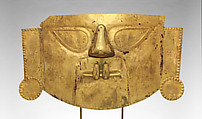Funerary mask
Not on view
This large mask depicting a face with large upturned eyes, prominent nose, thin mouth, and ornaments below the nose and on the ears, once formed part of the funerary regalia of a deceased ruler on Peru’s north coast. Masks made of hammered sheet metal have been found in tombs of both men and women in the Lambayeque region, near the modern city of Chiclayo. Such masks are lacking perforations or openings that would have allowed mortals to see or breathe, and were most likely used exclusively to cover the faces of deceased individuals of high status. In one tomb from Batán Grande, a major center of the Lambayeque culture (also known as Sicán), one mask was found over the face of a mummy, and four others were placed at the foot of the deceased. Although such masks may have only been worn by the dead, danglers attached to the mask would have conveyed a sense of movement, perhaps life, as the mummy bundle was processed to its final resting place deep within a monumental platform mound. Only two danglers below the nose survive on this mask, although at one time many more were present, as indicated by the pairs of perforations on the ears and ear ornaments.
Funerary masks of this type vary in size. This mask is one of the largest known, indeed it is one of the largest objects of precious metal known from the ancient Americas. Most are made from a single sheet of hammered gold alloy; in the present example the nose was sculpted separately and attached to the face with four tabs. The mask was made of a ternary alloy known as tumbaga, containing 40 percent gold, 49 percent silver, and 11 percent copper, by weight. The gold appearance was achieved through a process known as depletion gilding, where the copper and silver are removed from the surface of the object through hammering and chemical enrichment.
Most of the applied pigment is lost on this mask, but traces of cinnabar, a red mineral pigment, can be seen along the edges of the cheeks and mouth. Other masks retain more of their original pigment (see 1974.271.35), and some were also embellished with feathers, precious stones, and overlays of silver-surfaced metals. The ovoid eyes terminating in a point are characteristically Lambayeque in style, and may represent a being known as the Sicán Deity. According to Izumi Shimada and colleagues, an individual interred with such a mask would have been thought to take on aspects of the Sicán Deity’s power, and would have been transformed into venerated ancestors upon death.
Joanne Pillsbury, Andrall E. Pearson Curator, 2015
Further Reading
Elera, Carlos G. “The Face Behind the Mask,” in Victor Pimentel, ed.,
Hildebrand, Joyce, Karen Buckley, eds. Ancient Peru Unearthed: Golden Treasures of a Lost Civilization. Exh. cat. Calgary: The Nickle Arts Museum, University of Calgary Press, 2006.
Jones, Julie, ed. The Art of Precolumbian Gold: The Jan Mitchell Collection. Exh. cat. Boston: Little Brown, 1985.
Jones, Julie, and Heidi King. Gold of the Americas. New York: The Metropolitan Museum of Art, 2002.
King, Heidi. Rain of the Moon: Silver in Ancient Peru. With contributions by Luis Jaime Castillo Butters and Paloma Carcedo de Mufarech. Exh. cat. New York: Metropolitan Museum of Art; New Haven, Conn.: Yale University Press, 2000.
Mackey, Carol J. and Joanne Pillsbury. “Cosmology and Ritual on a Lambayeque Beaker,” in Margaret Young-Sánchez, ed., Pre-Columbian Art & Archaeology: Essays in Honor of Frederick R. Mayer, pp. 115-141. Denver: Denver Art Museum.
Shimada, Izumi, ed. Cultura Sicán: Esplendor preincaico de la costa norte. Translated by Gabriela Cervantes. Lima: Fondo Editorial del Congreso del Perú, 2014.
Shimada, Izumi. Cultura Sicán: Dios, riqueza y poder en la costa norte del Perú. Lima: Fundación del Banco Continental para el Fomento de la Educación y la Cultura, Edubanco, 1995.
Shimada, Izumi, and Jo Ann Griffin. “Precious Metal Objects of the Middle Sican.” Scientific American (April 2004), pp. 80-89.
Shimada, Izumi, Jo Ann Griffin, and Adon Gordus. “The Technology, Iconography, and Social Significance of Metals: A Multidimensional Analysis of Middle Sicán Objects,” in Colin McEwan, ed., Precolumbian Gold: Technology, Style and Iconography, pp. 28-61. London: The British Museum, 2000.
Shimada, Izumi, Ken-ichi Shinoda, Julie Farnum, Robert S. Corruccini, and Hirokatsu Watanbe. “An Integrated Analysis of Pre-Hispanic Mortuary Practices: A Middle Sicán Case Study.” Current Anthropology 45, no. 3 (2004), pp. 369-402.
Wester la Torre, Carlos. Mystery and History in the Lambayeque Culture: The Priestess of Chornancap. Lambayeque: Museo Arqueológico Nacional Brüning, 2013.
Due to rights restrictions, this image cannot be enlarged, viewed at full screen, or downloaded.
This artwork is meant to be viewed from right to left. Scroll left to view more.





